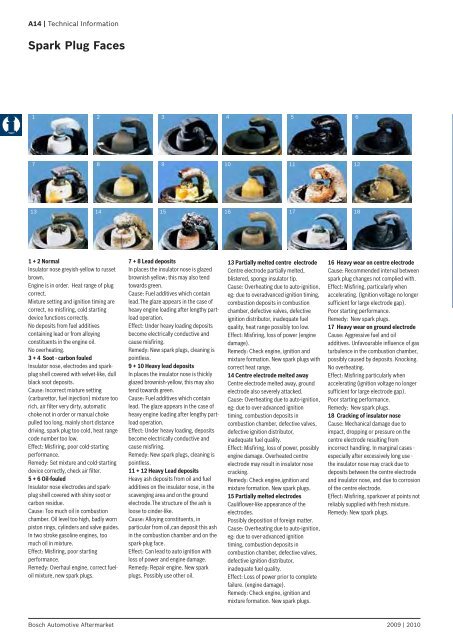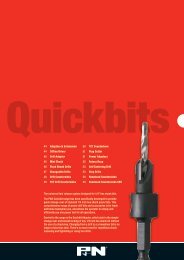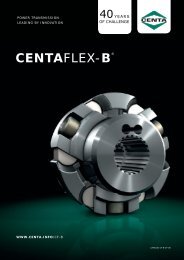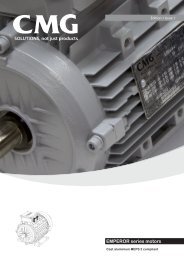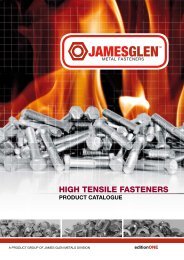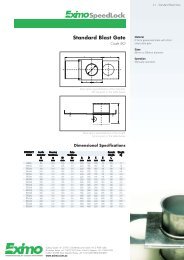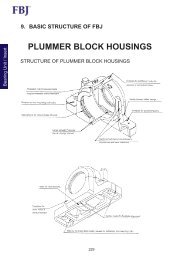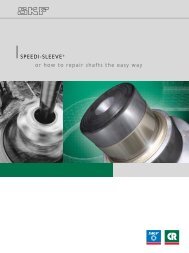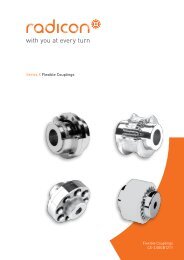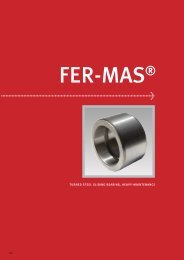LPG Spark Plugs - Industrial and Bearing Supplies
LPG Spark Plugs - Industrial and Bearing Supplies
LPG Spark Plugs - Industrial and Bearing Supplies
You also want an ePaper? Increase the reach of your titles
YUMPU automatically turns print PDFs into web optimized ePapers that Google loves.
A14<br />
A14 | Technical Information<br />
<strong>Spark</strong> Plug Faces<br />
1 2 3 4 5 6<br />
7 8 9 10 11 12<br />
13 14 15 16 17 18<br />
1 + 2 Normal<br />
Insulator nose greyish-yellow to russet<br />
brown.<br />
Engine is in order. Heat range of plug<br />
correct.<br />
Mixture setting <strong>and</strong> ignition timing are<br />
correct, no misfiring, cold starting<br />
device functions correctly.<br />
No deposits from fuel additives<br />
containing lead or from alloying<br />
constituents in the engine oil.<br />
No overheating.<br />
3 + 4 Soot - carbon fouled<br />
Insulator nose, electrodes <strong>and</strong> sparkplug<br />
shell covered with velvet-like, dull<br />
black soot deposits.<br />
Cause: Incorrect mixture setting<br />
(carburettor, fuel injection) mixture too<br />
rich, air filter very dirty, automatic<br />
choke not in order or manual choke<br />
pulled too long, mainly short distance<br />
driving, spark plug too cold, heat range<br />
code number too low.<br />
Effect: Misfiring, poor cold-starting<br />
performance.<br />
Remedy: Set mixture <strong>and</strong> cold-starting<br />
device correctly, check air filter.<br />
5 + 6 Oil-fouled<br />
Insulator nose electrodes <strong>and</strong> sparkplug<br />
shell covered with shiny soot or<br />
carbon residue.<br />
Cause: Too much oil in combustion<br />
chamber. Oil level too high, badly worn<br />
piston rings, cylinders <strong>and</strong> valve guides.<br />
In two stroke gasoline engines, too<br />
much oil in mixture.<br />
Effect: Misfiring, poor starting<br />
performance.<br />
Remedy: Overhaul engine, correct fueloil<br />
mixture, new spark plugs.<br />
7 + 8 Lead deposits<br />
In places the insulator nose is glazed<br />
brownish yellow; this may also tend<br />
towards green.<br />
Cause: Fuel additives which contain<br />
lead.The glaze appears in the case of<br />
heavy engine loading after lengthy partload<br />
operation.<br />
Effect: Under heavy loading deposits<br />
become electrically conductive <strong>and</strong><br />
cause misfiring.<br />
Remedy: New spark plugs, cleaning is<br />
pointless.<br />
9 + 10 Heavy lead deposits<br />
In places the insulator nose is thickly<br />
glazed brownish-yellow, this may also<br />
tend towards green.<br />
Cause: Fuel additives which contain<br />
lead. The glaze appears in the case of<br />
heavy engine loading after lengthy partload<br />
operation.<br />
Effect: Under heavy loading, deposits<br />
become electrically conductive <strong>and</strong><br />
cause misfiring.<br />
Remedy: New spark plugs, cleaning is<br />
pointless.<br />
11 + 12 Heavy Lead deposits<br />
Heavy ash deposits from oil <strong>and</strong> fuel<br />
additives on the insulator nose, in the<br />
scavenging area <strong>and</strong> on the ground<br />
electrode.The structure of the ash is<br />
loose to cinder-like.<br />
Cause: Alloying constituents, in<br />
particular from oil,can deposit this ash<br />
in the combustion chamber <strong>and</strong> on the<br />
spark-plug face.<br />
Effect: Can lead to auto ignition with<br />
loss of power <strong>and</strong> engine damage.<br />
Remedy: Repair engine. New spark<br />
plugs. Possibly use other oil.<br />
13 Partially melted centre electrode<br />
Centre electrode partially melted,<br />
blistered, spongy insulator tip.<br />
Cause: Overheating due to auto-ignition,<br />
eg: due to overadvanced ignition timing,<br />
combustion deposits in combustion<br />
chamber, defective valves, defective<br />
ignition distributor, inadequate fuel<br />
quality, heat range possibly too low.<br />
Effect: Misfiring, loss of power (engine<br />
damage).<br />
Remedy: Check engine, ignition <strong>and</strong><br />
mixture formation. New spark plugs with<br />
correct heat range.<br />
14 Centre electrode melted away<br />
Centre electrode melted away, ground<br />
electrode also severely attacked.<br />
Cause: Overheating due to auto-ignition,<br />
eg: due to over-advanced ignition<br />
timing, combustion deposits in<br />
combustion chamber, defective valves,<br />
defective ignition distributor,<br />
inadequate fuel quality.<br />
Effect: Misfiring, loss of power, possibly<br />
engine damage. Overheated centre<br />
electrode may result in insulator nose<br />
cracking.<br />
Remedy: Check engine,ignition <strong>and</strong><br />
mixture formation. New spark plugs.<br />
15 Partially melted electrodes<br />
Cauliflower-like appearance of the<br />
electrodes.<br />
Possibly deposition of foreign matter.<br />
Cause: Overheating due to auto-ignition,<br />
eg: due to over-advanced ignition<br />
timing, combustion deposits in<br />
combustion chamber, defective valves,<br />
defective ignition distributor,<br />
inadequate fuel quality.<br />
Effect: Loss of power prior to complete<br />
failure. (engine damage).<br />
Remedy: Check engine, ignition <strong>and</strong><br />
mixture formation. New spark plugs.<br />
16 Heavy wear on centre electrode<br />
Cause: Recommended interval between<br />
spark plug changes not complied with.<br />
Effect: Misfiring, particularly when<br />
accelerating. (Ignition voltage no longer<br />
sufficient for large electrode gap).<br />
Poor starting performance.<br />
Remedy: New spark plugs.<br />
17 Heavy wear on ground electrode<br />
Cause: Aggressive fuel <strong>and</strong> oil<br />
additives. Unfavourable influence of gas<br />
turbulence in the combustion chamber,<br />
possibly caused by deposits. Knocking.<br />
No overheating.<br />
Effect: Misfiring particularly when<br />
accelerating (ignition voltage no longer<br />
sufficient for large electrode gap).<br />
Poor starting performance.<br />
Remedy: New spark plugs.<br />
18 Cracking of insulator nose<br />
Cause: Mechanical damage due to<br />
impact, dropping or pressure on the<br />
centre electrode resulting from<br />
incorrect h<strong>and</strong>ling. In marginal cases -<br />
especially after excessively long use -<br />
the insulator nose may crack due to<br />
deposits between the centre electrode<br />
<strong>and</strong> insulator nose, <strong>and</strong> due to corrosion<br />
of the centre electrode.<br />
Effect: Misfiring, sparkover at points not<br />
reliably supplied with fresh mixture.<br />
Remedy: New spark plugs.<br />
Bosch Automotive Aftermarket 2009 | 2010


